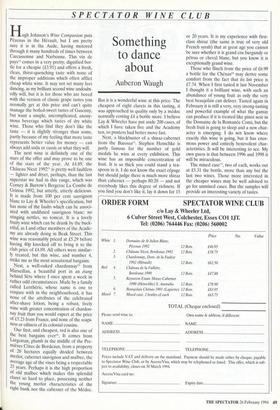SPECTATOR WINE CLUB
Something to dance about
Auberon Waugh
Hugh Johnson's Wine Companion puts Pezenas in the Herault, but I am pretty sure it is in the Aude, having motored through it many hundreds of times between Carcassonne and Narbonne. This yin de pays') comes in a very pretty, dignified bot- tle for a cheapie (£3.91) and offers a fresh, clean, thirst-quenching taste with none of the improper additions which often afflict cheap white wine. It may not set many feet dancing, as my brilliant second wine undoubt- edly will, but it is for those who are bored with the version of classic grape tastes you normally get at this price and can't quite manage the boiled-sweet tastes of Gascony, but want a simple, uncomplicated, anony- mous beverage which tastes of dry white wine. Those who find they don't like the taste — it is slightly stronger than some, partly because of my feeling that more taste represents better value for money — can always add soda or cassis or what they will.
The next wine is definitely one of the stars of the offer and may prove to be one of the stars of the year. At £4.89, the Château Nicot 1992(2) is pretty well faultless — lighter and dryer, perhaps, than the last superstar we had in this range, which was Corney & Barrow's Bergerac La Combe de Grinou 1992, but utterly, utterly delicious. It is made from 100 per cent sauvignon blanc to Lay & Wheeler's specification, but has none of the faults which can be associ- ated with undiluted sauvignon blanc: no stinging nettles, no tomcat. It is a lovely fruity wine which can be drunk by the buck- etful, as I and other members of the Acade- my are already doing in Beak Street. This wine was reasonably priced at £5.29 before having 40p knocked off to bring it to the club price of £4.89. All others were similar- ly treated, but this wine, and number 4, strike me as the most sensational bargains.
Next, a well-oaked chardonnay43) from Marseillan, a beautiful port in an etang behind Sete where I once spent a week in rather odd circumstances. Made by a family called Lentheric, whose name is one to
Conjure with in the neighbourhood, it has none of the attributes of the celebrated after-shave lotion, being a robust, lively Wine with greater concentration of chardon- nay fruit than you would expect at the price of £5.23 from France, and none of the soapi- ness or oiliness of its colonial cousins.
Our first, and cheapest, red is also one of the best bargains ever'4). It comes from Largoiran, plumb in the middle of the Pre-
Inheres Cotes de Bordeaux, from a property of 20 hectares equally divided between merlot, cabernet sauvignon and malbec, the average age of the vines being a respectable 25 years. Perhaps it is the high proportion of old malbec which makes this splendid claret so hard to place, possessing neither the young merlot characteristics of the right bank nor the cabernet of the Medoc. But it is a wonderful wine at this price. The cheapest of eight clarets in this tasting, it was approached in quality only by a medoc normally costing £4 a bottle more. I believe Lay & Wheeler have put aside 200 cases, of which I have taken five and the Academy ten, so punters had better move fast.
Next, a blockbuster of a shiraz-cabernet from the Barosse. Stephen Henschke is justly famous for the number of gold medals he wins at every exhibition. This wine has an impossible concentration of fruit. It is so thick you could stand a tea- spoon in it. I do not know the exact cepage but should judge there is much more shiraz than cabernet — perhaps 80:20 — and not everybody likes this degree of richness. If you find you don't like it, lay it down for 15 or 20 years. It is my experience with first- class shiraz (the same is true of very old French syrah) that at great age you cannot be sure whether it is grand cru burgundy or petrus or cheval blanc, but you know it is exceptionally grand wine.
Those who flinch from the price of £6.99 a bottle for the Chenaso) may derive some comfort from the fact that its list price is £7.74. When I first tasted it last November I thought it a brilliant wine, with such an abundance of young fruit as only the very best beaujolais can deliver. Tasted again in February it is still a very, very strong-tasting and powerful example of what the gamay can produce if it is treated like pinot noir in the Domaine de la Roman& Conti, but the fresh fruit is going to sleep and a new char- acter is emerging. I do not know where exactly this wine is going, but it has enor- mous power and entirely benevolent char- acteristics. It will be interesting to see. My own guess is that between 1996 and 1998 it will be miraculous.
The mixed case, two of each, works out at £5.31 the bottle, more than any but the last two wines. Those more interested in the cheaper wines may be well advised to go for unmixed cases. But the samples will provide an interesting variety of tastes.


























































 Previous page
Previous page